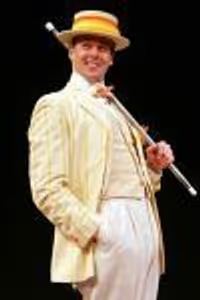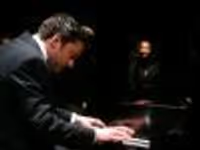Head voice/Falsetto- something to be shunned?
Hoof
Featured Actor Joined: 5/14/05
#0Head voice/Falsetto- something to be shunned?
Posted: 12/30/05 at 10:46pmIn curiousity, do most directors and really, anyone involved in professional theatre feel that using head voice is a bad thing?
#1re: Head voice/Falsetto- something to be shunned?
Posted: 12/31/05 at 4:13amno...? Why would they? Head voice is a different texture of sound and is used aaaaaaaaaaall the time in theater. Why do you ask?
Hoof
Featured Actor Joined: 5/14/05
#2re: Head voice/Falsetto- something to be shunned?
Posted: 12/31/05 at 1:32pm
Just because my full voice is small in range, but my head voice is much larger and has that mixed quality. It's more of a 'Sherie Rene Scott' quality, and I was just wondering if it's looked down upon as a person having a crummy range.
Lol Does that make any sense?
#3re: Head voice/Falsetto- something to be shunned?
Posted: 12/31/05 at 4:59pm
It doesn't necessarily mean that you have a bad range or are a bad singer. Head voice is another thing that actors can use to tell the story. It also depends on what the director is looking for; Mandy Patinkin seems to sing almost exclusively in head voice.
For females, purely from a singing standpoint, the trick is to get your chest voice and your head voice to sound as similar to each other as you can, and, in doing so, to make your break not as noticable.
Hope that helps.
Hoof
Featured Actor Joined: 5/14/05
#4re: Head voice/Falsetto- something to be shunned?
Posted: 1/1/06 at 10:41amIt really does, thank you. I feel a little better now. Haha.
#5re: Head voice/Falsetto- something to be shunned?
Posted: 1/1/06 at 4:03pmDo you sing opera is a head voice?
#6re: Head voice/Falsetto- something to be shunned?
Posted: 1/1/06 at 4:08pm
Wow, that makes me feel a lot better too! I also have a kind of small range in my full voice, but my head voice is very loud and clear and I can go quite high. I was worried that singing in a head voice was an "easy way out" or something. Whew! ![]()
*dances around*
#7re: Head voice/Falsetto- something to be shunned?
Posted: 1/1/06 at 4:15pmSo, do you sing in a head voice for opera?
jimmycurry01
Broadway Legend Joined: 5/28/05
#8re: Head voice/Falsetto- something to be shunned?
Posted: 1/1/06 at 5:31pmMy musical theatre professor at USI is always pushing people to not be afraid of their head voice. If you have a large range ther then use it.
Blair
Broadway Star Joined: 11/4/03
#9re: Head voice/Falsetto- something to be shunned?
Posted: 1/1/06 at 6:41pm
Actually, I always advocate singing in head voice as much as possible. Purely chest voice can be very damaging.
Classical singing and, yes, opera, is done in head voice. The difference between a musical theatre head voice and classical singing is that musical theatre is as bright as humanly possible. To use examples, Kelli O'Hara, Kristin Chenoweth, Laura Benanti...all have beautiful musical theatre head voices.
If you want to belt, please, PLEASE use a bit of head voice in there. It's healthier and easier on the cords. And it's also a prettier sound, in my opinion.
This is the reasoning that everyone always says that classical training is essential in the development of a musical theatre voice. With classical training you know how to use head voice, all you have to do is modulate it to make it brighter and you have a musical theatre head voice. Then you mix in some chest and you have a kind of belt sound that doesn't hurt you. It's the basis for all types of singing.
#10re: Head voice/Falsetto- something to be shunned?
Posted: 1/1/06 at 8:02pm
modulate it? doesn't that mean change keys?
and, assuming there's another meaning for it, how would you do that?
Blair
Broadway Star Joined: 11/4/03
#11re: Head voice/Falsetto- something to be shunned?
Posted: 1/1/06 at 8:45pm
No, by modulate I just mean change the sound, not change keys.
A simple way to get brighter is to smile when you sing, but make sure the placement stays on the hard palate, not the soft. There are a few other ways, but they would be difficult to describe in writing.
#12re: Head voice/Falsetto- something to be shunned?
Posted: 1/2/06 at 4:16amI pretty much completely agree with you. However, it is possible to work almost exclusively on Musical Theater stuff, but still train a good head voice and sing healthily. As a male, I'm just starting to discover my falsetto and use it while actually performing. It's hard to trust at first but definitely useful.
#13re: Head voice/Falsetto- something to be shunned?
Posted: 1/3/06 at 5:11pmThis thread has seriously made me very, very happy.
#14re: Head voice/Falsetto- something to be shunned?
Posted: 1/4/06 at 1:19amMy problem with my falsetto is that it has a totally different tone from my normal voice. For instance, if I'm in full voice and belting something then switch to my falsetto it sounds like poop...
#15re: Head voice/Falsetto- something to be shunned?
Posted: 1/4/06 at 1:01pm
Try to add a little bit of your chest voice into your head tone, say like 90% head, 10% chest. Just experiment with it a bit, and try to get the timbre of each to sound more similar to each other.
A good exercise to get you to pass more easily and naturally from head to chest voice is, on an "ah", start up as high as you can in you head voice and slide all the way down into your chest voice. What you're trying to do in this exercise is to not make it obvious where the break is in your voice. Once you get this down, try starting at the bottom and going all the way to the top, and then back down, so you're going over your break twice. Once you get that, try "spirals" which starts at the bottom, goes up, then back down, and up and back down and so forth until you reach the top, and then slide back down. In this way you are going over your break several times, and have to really focus each time on making the transition between head and chest tone not obvious.
Again, I hope this is helpful.
Hoof
Featured Actor Joined: 5/14/05
#16re: Head voice/Falsetto- something to be shunned?
Posted: 1/4/06 at 6:14pm
Thanks for the advice on the mixing; I have a noticable break, and usually if I see a "C" I get anxious because I know it'll break the flow, and these exercises seem to help.
Anyways, this thread has been surprisingly helpful. I'm impressed with myself ![]()
#17re: Head voice/Falsetto- something to be shunned?
Posted: 1/13/06 at 11:53am
ok, so you have three voices (both males and females)
Voice #1-Chest. This is youre brute belting voice, and is in the lowest part of youre range. Its fine to "belt" here if you are doing it down the scale, but belting higher in this voice is VERy dangerous, and isn't pretty to listen to.
Voice #2-Head- This is where you sing most "soprano" pieces, and can be mixed with you chest voice for that typical sheri renee scott belt voice. most classical singing is done in this voice, with the exception of some higher parts which is done in.....
Voice #3!- Loft/Falsetto voice- This is where you sing those ridicuosly high notes.
Passagio is the place between the voices. This can always expand, but it will also always be there. Working through your passagio is a good thing because it leads to a well blended slide through the voices.
Examples of where certain songs would probably be sung-
"These are my Children"-Fame (chest)
"Still Hurting"- The Last Five Years (chest and head mixed)
"If I Loved You"-Carousel (head)
"Glitter and Be Gay"-Candide (head and loft)
...and there often isn't any song that is sung COMPLETLY in your loft voice. MAYBE some opera, but again, its usually for hitting those "money" notes.
Hope this has been helpful.
#18re: Head voice/Falsetto- something to be shunned?
Posted: 1/13/06 at 2:47pmActually, I've read that female singers only have two voices, a head and a chest voice. I could be wrong, although it seems like I read it in a voice pedagogy book.
WOSQ
Broadway Legend Joined: 7/18/03
#19re: Head voice/Falsetto- something to be shunned?
Posted: 1/13/06 at 4:44pm
Men with strong falsettos aka countertenors aka male altos--
NY City Opera has been on a Handel binge for maybe 7 seasons. They do one of his rarely produced operas a season.
Each of these operas has at least one role written for a countertenor which is a male alto and is sung entirely in falsetto.
Listen to some of the Handel operas for this type of singing or find current CDs by the likes of David Daniels.
It is possible to develop your loft range into a full fledged voice. Lessons will show you how to do this without doing damage to your voice.
Countertenors are finding all sorts of work all over the place these days.
For that matter Mary Sunshine in Chicago is a countertenor role.
#20re: Head voice/Falsetto- something to be shunned?
Posted: 1/13/06 at 6:09pm
This is probably well known, but in case it's not...
In classical music times, some boys were castrated to preserve their beautiful young voices. Castratos, as they were called, were written into many operas. Nowadays, these parts are usually played by women.
Now that's dedication to your craft.
#21re: Head voice/Falsetto- something to be shunned?
Posted: 1/13/06 at 10:41pmJust to add - I have had to sing songs which basically lived in my Passagio. Although I wanted to break out the voodoo dolls and kick some composer butt, it greatly helped blend my chest and head voices. No matter how much it sucks, sing it.
Sporti2005
Broadway Legend Joined: 12/13/04
#23re: Head voice/Falsetto- something to be shunned?
Posted: 2/2/06 at 4:08pm
if you don't use head voice at all you will completely ruin your voice...seriously.
a little chest can go a long way when it comes to mixing.
Videos






